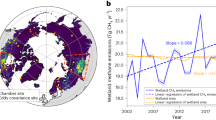Abstract
Wetlands play a role in regulating global climate by removing carbon dioxide (CO2) from the atmosphere and sequestering it as soil carbon, and by emitting methane (CH4) and nitrous oxide (N2O) to the atmosphere. In a recent article in this journal (Mitsch et al. Landscape Ecol 28:583–597, 2013), CO2 sequestration and CH4 emissions were modeled for several freshwater wetlands that vary in vegetation type, climate, and hydrology. The authors of that study made significant errors that caused them to underestimate the importance of wetland CH4 emissions on climate dynamics. Here, I reanalyze the Mitsch et al. dataset and show that all of their wetlands had an initial warming effect but eventually caused negative net radiative forcing within ~60–14,000 years, depending on the ratio of CO2 sequestration to CH4 emissions. The addition of a N2O component to the model suggested that typical wetland N2O emission rates would contribute only a minor burden to wetland radiative forcing, although specific application of this three-gas model is limited by the paucity of sites where CO2 sequestration, CH4 emission, and N2O exchange rates have all been measured. Across the landscape, many natural wetlands may already cause negative net radiative forcing when integrated over their lifetime. However, caution should be applied when using carbon sequestration as a rationale for designing wetland construction and restoration projects since freshwater wetlands may have a net positive (warming) effect on climate for decades to centuries or longer.



Similar content being viewed by others
References
Bridgham SD, Cadillo-Quiroz H, Keller JK, Zhuang Q (2013) Methane emissions from wetlands: biogeochemical, microbial, and modeling perspectives from local to global scales. Glob Change Biol 19:1325–1346
Conrad R (2009) The global methane cycle: recent advances in understanding the microbial processes involved. Environ Microbiol Rep 1:285–292
Craft CB (2007) Freshwater input structures soil properties, vertical accretion, and nutrient accumulation of Georgia and U.S. tidal marshes. Limnol Oceanogr 52:1220–1230
Forster P, Ramaswamy V, Artaxo P, Berntsen T, Betts R, Fahey DW, Haywood J, Lean J, Lowe DC, Myhre G, Nganga J, Prinn R, Raga G, Schulz M, Van Dorland R (2007) Changes in atmospheric constituents and in radiative forcing. In: Solomon S, Qin D, Manning M, Chen Z, Marquis M, Averyt KB, Tignor M, Miller HL (eds) Climate change 2007: the physical science basis. Contribution of Working Group I to the Fourth Assessment Report of the Intergovernmental Panel on Climate Change. Cambridge University Press, Cambridge/New York, pp 130–234
Frolking S, Roulet NT (2007) Holocene radiative forcing impact of northern peatland carbon accumulation and methane emissions. Glob Change Biol 13:1079–1088
Frolking S, Roulet N, Fuglestvedt J (2006) How northern peatlands influence the earth’s radiative budget: sustained methane emission versus sustained carbon sequestration. J Geophys Res 111:G01008
Mitra S, Wassmann R, Vlek PLG (2005) An appraisal of global wetland area and its organic carbon stock. Curr Sci 88:25–35
Mitsch WJ, Wilson RF (1996) Improving the success of wetland creation and restoration with know-how, time, and self-design. Ecol Appl 6:77–83
Mitsch WJ, Bernal B, Nahlik AM, Mander U, Zhang L, Anderson CJ, Jørgensen SE, Brix H (2013) Wetlands, carbon, and climate change. Landscape Ecol 28:583–597
Moseman-Valtierra S (2012) Reconsidering the climatic role of marshes: are they sinks or sources of greenhouse gases? In: Abreu DC, de Borbón SL (eds) Marshes: ecology, management and conservation. Nova Scientific Publishers, Hauppauge, pp 1–48
Neubauer SC, Miller WD, Anderson IC (2000) Carbon cycling in a tidal freshwater marsh ecosystem: a carbon gas flux study. Mar Ecol Prog Ser 199:13–30
Neubauer SC, Anderson IC, Constantine JA, Kuehl SA (2002) Sediment deposition and accretion in a mid-Atlantic (U.S.A.) tidal freshwater marsh. Estuar Coast Shelf Sci 54:713–727
Shine KP, Fuglestvedt JS, Hailemariam K, Stuber N (2005) Alternatives to the global warming potential for comparing climate impacts of emissions of greenhouse gases. Clim Change 68:281–302
Siegenthaler U, Sarmiento J (1993) Atmospheric carbon dioxide and the ocean. Nature 365:119–125
Walker JCG (1991) Biogeochemical cycles of carbon on a hierarchy of time scales. In: Oremland RS (ed) Biogeochemistry of global change. Chapman and Hall, New York, pp 3–28
Acknowledgments
I thank Pat Megonigal, Scott Bridgham, and an anonymous reviewer for comments that significantly improved this manuscript. I also thank Steve Frolking for kindly answering questions about his atmospheric perturbation model.
Author information
Authors and Affiliations
Corresponding author
Rights and permissions
About this article
Cite this article
Neubauer, S.C. On the challenges of modeling the net radiative forcing of wetlands: reconsidering Mitsch et al. 2013. Landscape Ecol 29, 571–577 (2014). https://doi.org/10.1007/s10980-014-9986-1
Received:
Accepted:
Published:
Issue Date:
DOI: https://doi.org/10.1007/s10980-014-9986-1




